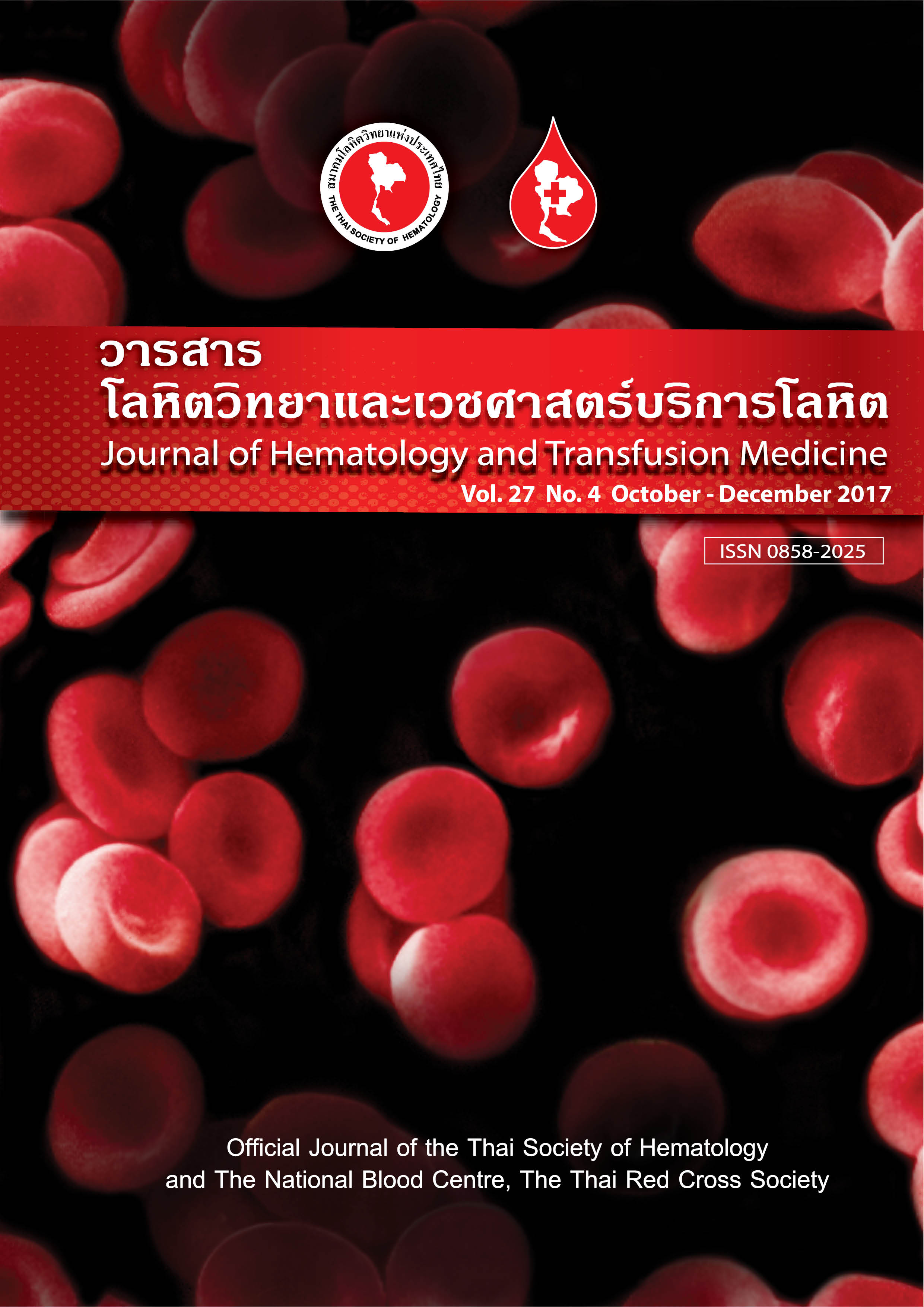หมู่เลือดพาราบอมเบย์ในครอบครัวหนึ่งของชาวไทยภาคใต้
Keywords:
H-deficiency, Para-Bombay Phenotype, Thai-family studyAbstract
บทคัดย่อ
เพื่อศึกษาเม็ดเลือดแดงในครอบครัวผู้บริจาคโลหิตที่ไม่มีแอนติเจนเอชบนผิวเม็ดเลือดแดง วิธีการศึกษา จัดทำแผนผังพงศาวลี จากการติดตามเก็บตัวอย่างเลือดของสมาชิกในครอบครัวได้รวม 7 คนประกอบด้วยพ่อแม่และ พี่น้อง 5 คนจากพี่น้องทั้งหมด 7 คน เพื่อทดสอบทางห้องปฏิบัติการประกอบด้วย ABO, Rh(D), Lewis, H antigen, saliva test, antibody screening test โดยวิธีหลอดมาตรฐาน ผลการศึกษา พ่อแม่เป็นหมู่เลือดปกติโดยพ่อหมู่บี (BH) แม่หมู่โอ (OH) ส่วนในพี่น้อง 5 คนพบเป็นหมู่เลือดพาราบอมเบย์จำนวน 2 คน โดยพบเป็นหมู่ O,H-deficient phenotype 1 คนและ B,H-deficient phenotype 1 คน ทั้ง 2 คนไม่มี anti-H/anti-HI ในซีรัม ส่วนพี่น้องอีก 3 คน เป็นหมู่โอ (OH)1 คน และหมู่บี (BH) 2 คน ทุกคนมีหมู่เลือด Rh(D) positive, Le(a-b-) และเป็น secretor สรุป H-deficiency phenotype ที่พบในผู้บริจาคโลหิตที่นำเสนอเป็นหมู่เลือดพาราบอมเบย์แบบ secretor เม็ดเลือดแดงมีลักษณะ weak ABH antigen แต่ตรวจพบสารหมู่เลือดในน้ำลายได้โดยวิธีหลอดมาตรฐาน และไม่พบ anti-H/anti-IH จึงทำให้ผล major crossmatch เข้ากันได้กับหมู่เลือดเอบีโอปกติ
Abstract:
The report aimed to study the weak ABH phenotype of a blood donor and her family for identifying H-deficient phenotype. Methods: Family pedigree was established with a total of 7 family members including parents and five from a total of seven siblings. Blood samples were collected for laboratory testing using the standard tube test. ABO, Rh(D), Lewis, H antigen, saliva ABH substance and antibody screening tests were performed. Results: The normal ABO group was found as B (BH) and O (OH), respectively in her father and mother. Among the five siblings, two O,H-deficient phenotype and B,H-deficient phenotype were identified as Oh and Bh para-Bombay without anti-H/anti-HI in their serum, the other three siblings had normal ABO blood group (OH, BH, BH). All family members were Rh(D) positive, Le(a-b-) and secretors. Conclusion: The H-deficiency phenotype case, found in a blood donor, was Bh para-Bombay. The typical characteristic was the weak ABH antigen on red blood cells, but ABH blood group substances were found in saliva by standard tube test. The case has no anti-H/anti-IH, compatible resulting in major cross-matching with normal ABO blood donors.



